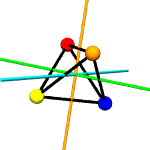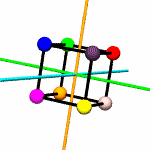"""
Set domain = string.digits if you want to work with
integers instead of printable letters -- or experiment
with other domains
"""
_domain = string.printable
def mkcode():
"""
Return a string containing the elements in _domain
randomly permuted
"""
targ = list(_domain)
shuffle(targ)
return string.join(targ,"")
def mkdict(secretkey):
"""
Turns _domain + secretkey into a dictionary of
substitution pairs
"""
keydict = {}
j = 0
for i in _domain:
keydict[i]=secretkey[j]
j += 1
return keydict
The above utility,
mkcode( ), returns a shuffled _domain suitable for use the
string.mktrans( ) to generate a translation table. Python translation
tables are strings of 256 bytes in some new order.
mkdict(key)
pairs the _domain with the shuffled version to return a substitution
dictionary. Were I dealing with playing cards, the resulting dictionary
would randomly pair each card in Deck A with another in Deck
B. Because both decks have an equal number of cards, no card is without
its paired target -- which just might be the same card.
Usage:
>>> _domain = string.printable
>>> mycode = mkcode()
>>> mycode
'vOKiAYHXkDQmZfWwlGxIsduNJTrzPVocUbEjSgChnLqyFMaRpBte'
>>> mkdict(mycode)
{'z': 'T', 'x': 'N', 'y': 'J', 'v': 'd', 'w': 'u', 't': 'I',
'u': 's', 'r': 'G', 's': 'x', 'p': 'w', 'q': 'l', 'n': 'f',
'o': 'W', 'l': 'm', 'm': 'Z', 'j': 'D', 'k': 'Q', 'h': 'X',
'i': 'k', 'f': 'Y', 'g': 'H', 'd': 'i', 'e': 'A', 'b': 'O',
'c': 'K', 'a': 'v', 'Z': 'e', 'X': 'B', 'Y': 't', 'V': 'R',
'W': 'p', 'T': 'M', 'U': 'a', 'R': 'y', 'S': 'F', 'P': 'L',
'Q': 'q', 'N': 'h', 'O': 'n', 'L': 'g', 'M': 'C', 'J': 'j',
'K': 'S', 'H': 'b', 'I': 'E', 'F': 'c', 'G': 'U', 'D': 'V',
'E': 'o', 'B': 'z', 'C': 'P', 'A': 'r'}
So what's with _domain?
It's a module-level variable intially defined as all printable charaters
(= string.printable). But I might want to use integers or just uppercase
letters as my domain. Integers are what the group theory people tend use
when discussing permutations (i.e. substitution dictionaries). You can
always have numbers serve as stand-ins for letters, or for any other kind
of object, so moving to integers doesn't really change the basic mechanics
of the situation.
Alternative
usage:
>>> ciphers._domain = string.digits
>>> mycode = mkcode()
>>> mycode
'1639048572'
>>> mkdict(mycode)
{'8': '7', '9': '2', '6': '8', '7': '5', '4': '0', '5': '4',
'2': '3', '3': '9', '0': '1', '1': '6'}
Permutation Notation
Mathematicians have come up with an alternative notation for
representing the same information as in mycode.
Pick a number, any
number to start, then worm your way through the dictionary, training each
item to the one it maps to, e.g. using the above example, 8 maps
to 7 which maps to 5 and so on through 4, 0,
1, 7 and finally back to 8. Now organize this loop
into a tuple: ('8', '7', '5', '4', '0', '1', '6'),
with the understanding that each member is followed by its pair, with
the last member wrapping around to the first member, i.e. 6 maps
to 8.
We aren't finished
yet though, as we didn't get to all members with this single loop. 9
maps to 2 maps to 3 maps to 9 -- another cycle (loop),
with no members in common with the first (speaking more technically, we
can say the cycles are 'disjoint' meaning their intersection is the empty
set).
Perhaps you will want
to try writing a short Python routine that takes such a dictionary of
unshuffled,shuffled pairs, as up top, and converts same to a list of cyclic
tuples, as per the above example. The cycles2dict
method included in the source module (ciphers.py) shows one possible
solution.
Usage:
>>> p = cycles2dict(mkdict(mycode))
>>> p
[('8', '7', '5', '4', '0', '1', '6'), ('9', '2', '3')]
And you'd
want to make it bidirectional:
>>> dict2cycles(p)
{'8': '7', '9': '2', '6': '8', '7': '5', '4': '0',
'5': '4', '2': '3', '3': '9', '0': '1', '1': '6'}
The thing to
realize is that when a code pairs a letter with itself (or number
with itself), you simply don't mention it in the cycles notation.
Like, if it's the 'identity dictionary' (every letter is
paired with itself), then the list of corresponding cyclic tuples
is empty, and vice versa:
>>> dict2cycles({1:1,2:2,3:3,4:4}) # identity dictionary returns [ ]
[ ]
>>> ciphers._domain = string.uppercase
>>> cycles2dict([])
{'Z': 'Z', 'X': 'X', 'Y': 'Y', 'V': 'V', 'W': 'W', 'T': 'T' ... etc.}
Symmetry Groups
Group theory
meets geometry when we consider symmetry groups. What
rotations may we apply to a geometric shape such that it
superimposes on itself? In other words, what rotations around what
axes will permit you overlay the "before" and "after" pictures of a
shape, and have them align perfectly?
When you
rotate a square flat on the table by 90 degrees, it looks just the
way it did before. You might also flip it over, like a pancake, and
yet still have it look the same (except maybe the two sides have
different colors). The same ideas apply not just to polygons (flat
shapes) but to polyhedra (spatial shapes).
Think of
colored spheres stuck on the four corners of a tetrahedron. We can
use permutations to describe the ways these spheres might swap
around with one another in ways consistent with rotation around
various axes. The permutations act on the set of
vertices.
For example,
suppose you put a tetrahedron on a table and hold the apex fixed
with your thumb, while rotating the base triangle 120 degrees.
Three base spheres move to adjacent positions, with the 3rd coming
round to occupy the position formerly held by the first. If these
spheres were labeled A,B and C, the
permutation might be expressed as
[('A','B','C')]. The apex sphere, D, does not move,
and so does not get mentioned in the permutation.
rotations.py contains a
Tetrahedron class which does little more than write itself out
to a file intelligible to
POV-Ray, a free ray tracing program. Accompanying this class
are the 12 possible permutations, including the identity
permutation (every sphere stays as it is), which describe the
tetrahedron's symmetry group.
|


